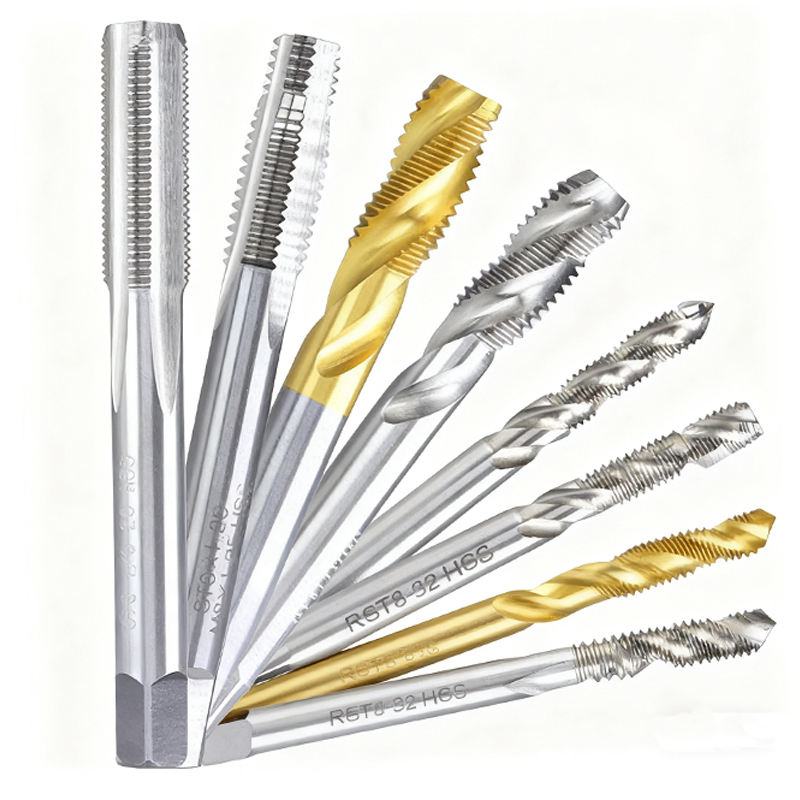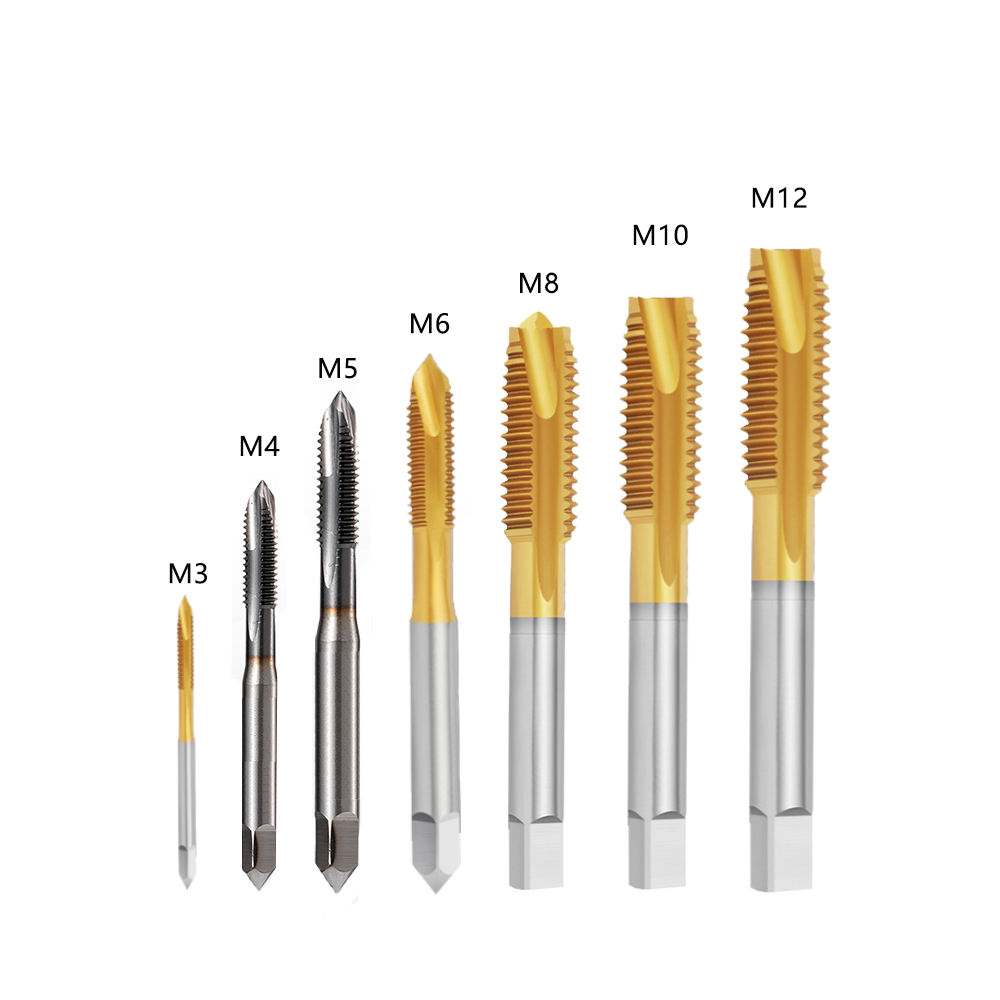What is a Screw Tap
A screw tap is a tool used for processing internal threads. According to its shape, it can be divided into spiral flute screw taps, rake angle screw taps, straight flute screw taps, and pipe thread screw taps, etc. Based on the application environment, it is categorized into hand screw taps and machine screw taps. In terms of specifications, there are metric, American, and British standard screw taps. The screw tap is the most mainstream processing tool adopted by manufacturers for tapping.

Introduction
A screw tap is a cutting tool for processing internal threads, with grooves along the axial direction. It is also called a “tap”. According to its shape, screw taps can be classified into straight flute screw taps, spiral flute screw taps, and spiral point screw taps (front-end screw taps).
Straight flute screw taps are easy to process, with slightly lower precision, and are produced in large quantities. They are generally used for thread processing on ordinary lathes, drilling machines, and tapping machines, with a relatively slow cutting speed. Spiral flute screw taps are mostly used for drilling blind holes in CNC machining centers, featuring fast processing speed, high precision, good chip removal, and excellent centering performance. Spiral point screw taps have chip flutes at the front, which are used for processing through holes.
Most screw taps supplied by tool factories are coated screw taps, which have significantly improved service life and cutting performance compared with uncoated screw taps. Screw taps with an unequal diameter design have a reasonable distribution of cutting load and high processing quality, but their manufacturing cost is also higher. Trapezoidal thread screw taps often adopt the unequal diameter design.

Components
Machine screw taps and hand screw taps are standard screw taps for cutting ordinary threads. In China, it is customary to refer to high-precision high-speed steel ground thread screw taps as machine screw taps, and rolled thread (or cut thread) screw taps made of carbon tool steel or alloy tool steel as hand screw taps. In fact, their structure and working principle are basically the same.
Typically, a screw tap consists of a working part and a shank part. The working part is further divided into a cutting part and a calibration part. The former is ground with a cutting cone and undertakes the cutting work, while the latter is used to calibrate the size and shape of the thread.
Applications
Screw taps are used for processing ordinary internal threads on nuts or other mechanical parts (i.e., tapping). Machine screw taps usually refer to high-speed steel ground thread screw taps, which are suitable for tapping on machine tools; hand screw taps refer to rolled thread (or cut thread) screw taps made of carbon tool steel or alloy tool steel, which are suitable for manual tapping.
As a tool for processing various medium and small-sized internal threads, the screw tap has a simple structure and is easy to use. It can be operated manually or on machine tools, and is widely used in production. For small-sized internal threads, the screw tap is almost the only processing tool. There are various types of screw taps, including hand screw taps, machine screw taps, nut screw taps, and extrusion screw taps.
Tapping is a relatively difficult processing procedure. This is because the screw tap is almost buried in the workpiece for cutting, the processing load per tooth is larger than that of other tools, and the contact area between the screw tap and the workpiece along the thread is very large. When cutting threads, the screw tap must accommodate and discharge chips. Therefore, it can be said that the screw tap works under very harsh conditions. To ensure smooth tapping, various possible issues should be considered in advance, such as the performance of the workpiece material, the selection of tools and machine tools, and the determination of cutting speed and feed rate.
Tapping on Special Workpiece Materials
The machinability of the workpiece material is the key factor affecting the difficulty of tapping. Currently, screw tap manufacturers mainly focus on developing screw taps for processing special materials. According to the properties of these materials, they adjust the geometric shape of the cutting part of the screw tap, especially its rake angle and hook (the degree of concavity on the front surface).
The maximum processing speed is sometimes limited by the performance of the machine tool. For smaller screw taps, the spindle speed required to reach the ideal speed [rpm = (sfm × 3.8) / screw tap diameter] may exceed the maximum spindle speed. On the other hand, high-speed cutting with larger screw taps will generate large torque, which may exceed the horsepower provided by the machine tool. When using internal cooling tools with 700psi pressure, the cutting speed can reach up to 250sfm; however, on machine tools without internal cooling equipment, the cutting speed can only reach 150sfm.
Unlike most metal cutting tools, the screw tap has a very large contact area with the workpiece hole wall, so cooling is crucial. If a high-speed steel screw tap overheats, it will break or burn. The geometric characteristics of the high-performance screw taps produced by NORIS Company include a larger relief angle and taper relief.
The aforementioned geometric shape of the screw tap, combined with a special coated surface (such as TiN, TiCN, CrN, or TiAlN), can greatly extend the service life of the screw tap. These heat-resistant and smooth coatings reduce cutting force and allow tapping at higher cutting speeds. In fact, the development of newer high-performance screw taps has greatly promoted the improvement of machine tool spindle speed and power.
Increasing Use of Carbide Screw Taps
Just as carbide tools have gradually replaced high-speed steel tools in turning, carbide screw taps have also begun to be more widely used in threaded hole processing. Compared with high-speed steel, carbide has higher hardness but greater brittleness. When using carbide screw taps for tapping, there is an issue of chip disposal. Nevertheless, carbide screw taps have excellent performance in processing cast iron and aluminum alloy materials, and their main damage form is mechanical wear.
Since the automotive industry processes a large number of cast iron and aluminum alloy parts, carbide screw taps are used to achieve a long tool service life. When processing workpieces made of these materials, carbide screw taps have a longer service life than high-speed steel screw taps. In the automotive industry, reducing the tool change time of screw taps is obviously an important factor, and the long service life of carbide screw taps minimizes the tool change time.
Using small helix angle carbide screw taps with surface coatings to tap aluminum alloy workpieces with a silicon content of 8%-12% yields excellent results. Screw taps made of submicron-grain carbide can increase tool toughness without reducing its hardness, and perform well in cutting hardened steel, plastics, and difficult-to-machine nickel-based alloys. The DL15 Ni series of special screw taps for nickel alloys produced by NORIS Company can continuously tap more than 200 threaded holes on the nickel-chromium-iron alloy Inconel 718 under certain conditions, whereas previously, regrinding was necessary to achieve this.
Functional Features
Screw taps are usually available in single-piece or set forms. Medium and small-sized through-hole threads can be tapped at one time with a single-piece screw tap. When processing blind holes or large-sized threaded holes, set screw taps are often used, i.e., more than 2 screw taps are used to complete the processing of one threaded hole in sequence.
Set screw taps have two designs: equal diameter and unequal diameter. For screw taps with equal diameter design, only the length of the cutting cone differs between each tap; for screw taps with unequal diameter design, the thread size of each tap is different, and only the last one has a complete tooth profile.


